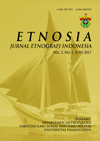Abstract
This article aims to analyze the myth of Sawerigading. The analysis approach is Structural Leivist analysis used to reveal the Structure in the myth of Sawerigading as a socio-cultural transformation and kinship structure to gain an understanding about the position of Sawerigading in the lagaligos epoch. The results show that the structure of Bugis-Makassar culture is always based on a divided binary opposition structure in three vertical parts, namely, upper structure, middle structure, and bottom. this structure originating from the cosmogini division transformed unconsciously and automatically into natural objects, house shape, and social stratification. Then, the existence of Sawerigading as a central character in the middle world is the result of the transformation of a limited exchange structure to the upper and the underworld kinship group through a marriage described as the foundation of the culture of Buginese and Makassarese people on earth. Liminal position on the myth of Sawerigading is a firm position to explain the reality of culture of the Buginese-Makassarese people. That is why the Buginese-Makassarese people have a strong and firm character.
References
Ahima-Putra H.S. (2009). Strukturalisme Levi-Strauss Mitos Dan Karya Sastra. Yogyakarta: kepel Press.
Creswell J. W. (2012). Research Design Pendekatan Kualitatif, Kuantitatif, dan Mixed. Yogyakarta: Pustaka Pelajar.
Danandjaja, James. ( 1990). Kegunaan Ceritra Rakyat Sawerigading Sebagai Sumber Sejarah Lokal Daerah-Daerah di Sulawesi dalam Sawerigading, Departemen Pendidikan dan Kebudayaan.
Lopa, Baharuddin. (1982 ). Hukum Laut Pelayaran dan Perniagaan, Penerbit, Alumni Bandung.
Marzali, Amri. (2016). Menulis Kajian Literatur. Etnosia: Jurnal Etnografi Indonesia. 1(2): 27-36.
Mattulada H. A. (1995). Latoa suatu Lukisan Analis terhadap Antropologi Politik Orang Bugis, penerbit Gadjah Mada University Press.
_______________. (1990). Sawerigading Dalam Identifikasi dan Analisi Dalam Sawerigading, Departemen Pendidikan dan Kebudayaan.
_______________. (1991). Manusia dan Kebudayaan Bugis-Makassar dan Kaili di Sulawesi dalam Antropologi Sosial dan Budaya Indonesia No. 48 Th. XV Januari-April 1991, diterbitkan Jurusan Antropologi FISIP, UI.
______________. (1997). Perubahan Sosial dan Kebudayaan Suku-Suku Bangsa di Sulawesi-Selatan, dalam Koentjaraningrat dan Antropologi di Indonesia (Masinambow Ed.), Penerbit AAI Kerjasama dengan YOI. Jakarta.
Moleong, L. J. (2014). Metode Penelitian Kuaitatif. Rosdakarya, Bandung.
Paeni, Muhlis. (1990). Pelayaran Sawerigading (Suatu Tinjauan Metahistoris Bugis) dalam Sawerigading, Departemen Pendidikan dan Kebudayaan.
Pelly, Usman. (1997). Pengaruh Islam dalam Pembuatan Perahu Bugis Pinisi dalam Koentjaraningrat dan Antropologi di Indonesia (Masinambow Ed.) Penerbit AAI kerjasama dengan YOI Jakarta.
Vansina, Jan. (1965). Oral Tradition. A Historical Methodology, H.M. Right Translated. Penguin Books.
van Peursen. (1978). Strategi Kebudayaan. Yogyakarta: Kanisius.





